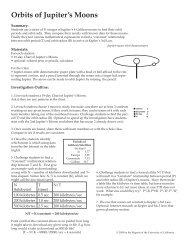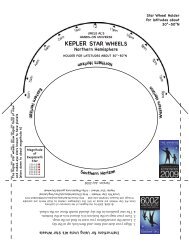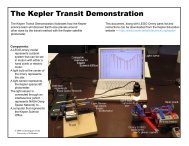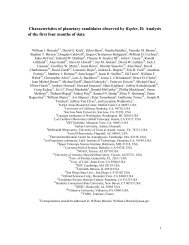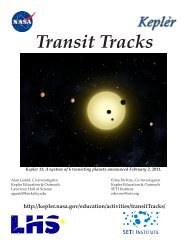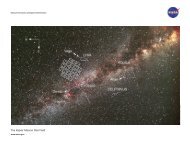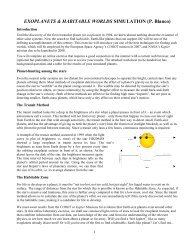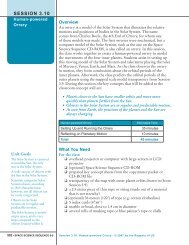Poster Abstracts - Kepler - NASA
Poster Abstracts - Kepler - NASA
Poster Abstracts - Kepler - NASA
- No tags were found...
Create successful ePaper yourself
Turn your PDF publications into a flip-book with our unique Google optimized e-Paper software.
POSTER ABSTRACTSExtragalactic Science With <strong>Kepler</strong>P1008. POSTER SESSION IIMichael N. Fanelli 1 , Pamela M. Marcum 2 and Cassidy Newton 3 ,1 <strong>NASA</strong>-Ames Research Center, MS 244-30, Moffett Field, CA, michael.n.fanelli@nasa.gov; 2 <strong>NASA</strong>-Ames ResearchCenter, pamela.m.marcum@nasa.gov; 3 Texas Christian Unversity, csmith2@tcu.eduAlthough designed as an exoplanet and stellar astrophysicsexperiment, the <strong>Kepler</strong> mission provides aunique capability to explore the essentially unknownphotometric stability of galactic systems at millimaglevels using <strong>Kepler</strong>'s blend of high precision and continuousmonitoring. Time series observations of galaxiesare sensitive to both quasi-continuous variability,especially low-level variations from embedded activenuclei, and random, episodic events, such as supernovae.In general, galaxies lacking active nuclei are notexpected to be variable on the timescales and amplitudesobserved in stellar sources and are free of sourcemotions that affect stars (e.g., parallax). These sourcescan serve as a population of quiescent, non-variablesources, which can be used to quantify the photometricstability and noise characteristics of the <strong>Kepler</strong> photometer.A factor limiting robust galaxy source selections inthe <strong>Kepler</strong> FOV is the lack of detailed quantitativeinformation about the galaxy population. The onlysystematic census of galaxies in this low galactic latitudefield is the 2MASS extended source catalog,which list ~11K sources at JHK magnitudes. Opticalphotometric and spectroscopic information is lacking,constraining for example the identification of AGNcandidates in this field.Despite these limitations, a significant and growingnumber of galaxies are being observed, forming the<strong>Kepler</strong> Galaxy Archive. Galaxy time series were/arebeing obtained by dedicated Guest Observer programsin Cycle 1-3 along with a small number of serendipitoussources found in the exoplanet survey. Observedsources total approximately 100, 250, and 700 in Cycles1-3 (Cycle 3 began in June 2011).In this poster we interpret the properties of a set of~20 galaxies monitored during quarters 4-8, their associatedlight curves, photometric and astrometric precisionand potential variability as revealed by periodograms.Data analysis issues relevant to extendedsources and available software tools will be discussed.In addition, we detail ongoing surveys which areproviding new photometric and morphological informationon galaxies over the entire field. These newdatasets will both aid the interpretation of the timeseries and improve source selection, e.g., help identifycandidate AGNs and starburst systems, for furthermonitoring.2011 <strong>Kepler</strong> Science Conference - <strong>NASA</strong> Ames Research Center 211



